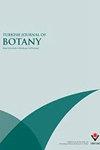Ellenberg ecological indicator values, tolerance values, species niche models for soil nutrient availability, salinity, and pH in coastal dune vegetation along a landward gradient (Euxine, Turkey)
IF 1.5
4区 生物学
Q3 PLANT SCIENCES
引用次数: 1
Abstract
: Coastal dunes are characterised by plant species adapted to harsh conditions. Salinity and other factors (soil pH, nutrients, and climate events) vary along the landward gradient. The current study investigated the effects of environmental factors on the occurrence and composition of coastal dune plants. Ellenberg ecological indicator values (EIVs), species tolerance values (TVs), and species niche models for salinity, nutrient availability, and soil reaction were determined. EIVs were estimated using weighted averages based on the species cover-abundance for each plot. Species TVs were calculated considering the cover-abundance and EIVs (pH, nutrient, and salinity). Species niche models were determined with the general linear model (GLM). GLM was computed using mean community EIVs, canopy height, and climatic variables. We found that salinity (S) and pH (R) EIVs decreased along the seaside-inland gradient while nitrogen (N) EIVs increased. TVs for S increased landward while S and R TVs decreased. According to GLM, niche models of 28 species for salinity, 25 species for pH, and 21 species for nutrient were significant. In summary, salinity and pH are the main drivers shaping coastal dune zonation and plant community.海岸带沙丘植被的Ellenberg生态指标值、容限值、物种生态位模型及其对土壤养分有效性、盐度和pH的影响(土耳其,Euxine)
:海岸沙丘的特点是植物种类适应恶劣的条件。盐度和其他因素(土壤pH值、营养物质和气候事件)随着向陆地的梯度而变化。本研究调查了环境因素对海岸沙丘植物发生和组成的影响。确定了艾伦伯格生态指示值(EIV)、物种耐受值(TV)以及盐度、养分有效性和土壤反应的物种生态位模型。EIV是根据每个地块的物种覆盖丰度使用加权平均值进行估计的。物种TV的计算考虑了覆盖丰度和EIV(pH、养分和盐度)。物种生态位模型采用广义线性模型(GLM)确定。GLM是使用平均群落EIV、冠层高度和气候变量计算的。我们发现,盐度(S)和pH(R)EIV沿海滨-内陆梯度降低,而氮(N)EIV增加。S的电视向陆地增加,而S和R的电视则减少。根据GLM,28种盐度、25种pH和21种养分的生态位模型是显著的。总之,盐度和pH是形成海岸沙丘分带和植物群落的主要驱动因素。
本文章由计算机程序翻译,如有差异,请以英文原文为准。
求助全文
约1分钟内获得全文
求助全文
来源期刊

Turkish Journal of Botany
PLANT SCIENCES-
CiteScore
2.90
自引率
5.60%
发文量
31
审稿时长
6-12 weeks
期刊介绍:
The Turkish Journal of Botany is published electronically 6 times a year by the Scientific and Technological Research Council of Turkey (TÜBİTAK) and accepts manuscripts (in English) covering all areas of plant biology (including genetics, evolution, systematics, structure, function, development, diversity, conservation biology, biogeography, paleobotany, ontogeny, functional morphology, ecology, reproductive biology, and pollination biology), all levels of organisation (molecular to ecosystem), and all plant groups and allied organisms (algae, fungi, and lichens). Authors are required to frame their research questions and discuss their results in terms of major questions in plant biology. In general, papers that are too narrowly focused, purely descriptive, or broad surveys, or that contain only preliminary data or natural history, will not be considered (*).
The following types of article will be considered:
1. Research articles: Original research in various fields of botany will be evaluated as research articles.
2. Research notes: These include articles such as preliminary notes on a study or manuscripts on the morphological, anatomical, cytological, physiological, biochemical, and other properties of plant, algae, lichen and fungi species.
3. Reviews: Reviews of recent developments, improvements, discoveries, and ideas in various fields of botany.
4. Letters to the editor: These include opinions, comments relating to the publishing policy of the Turkish Journal of Botany, news, and suggestions. Letters should not exceed one journal page.
(*) 1. Raw floristic lists (of algae, lichens, fungi, or plants), species descriptions, chorological studies, and plant sociology studies without any additional independent approaches.
2. Comparative morphology and anatomy studies (that do not cover a family, tribe, subtribe, genus, subgenus, section, subsection, or species complexes with taxonomical problems) without one or more independent additional approaches such as phylogenetical, micromorphological, chromosomal and anatomical analyses.
3. Revisions of family, tribe, genus, subgenus, section, subsection, or species complexes without any original outputs such as taxonomical status changes, IUCN categories, and phenological and ecological analyses.
4. New taxa of all plants without any additional independent approaches such as phylogenetical, ecological, chromosomal, chorological and correlational analyses in addition to a detailed macro- and micro-morphological descriptions with quality field and microscopic illustrations of taxonomically important structures and identification key in the taxonomic group.
New records of all plants without any additional independent approaches such as phylogenetical, ecological, chromosomal, chorological and correlational analyses in addition to a detailed macro- and micro-morphological descriptions with quality field and microscopic illustrations of taxonomically important structures and identification key in the taxonomic group may be accepted for peer review if they contain 3 or more new records or taxonomical status update, such as lectotypification, new combinations, transfers, revivals and synonyms.
5. New taxa of algae, lichens, and fungi without any additional independent approaches such as phylogenetical, ecological, chromosomal, chorological and correlational analyses in addition to a detailed macro- and micro-morphological descriptions with quality field and microscopic illustrations of taxonomically important structures and identification key in the taxonomic group.
New records of algae, lichens, and fungi without any additional independent approaches such as phylogenetical, ecological, chromosomal, chorological and correlational analyses in addition to a detailed macro- and micro-morphological descriptions with quality field and microscopic illustrations of taxonomically important structures and identification key in the taxonomic group may be accepted for peer review if they contain 5 or more new records or taxonomical status update, such as lectotypification, new combinations, transfers, revivals and synonyms.
 求助内容:
求助内容: 应助结果提醒方式:
应助结果提醒方式:


